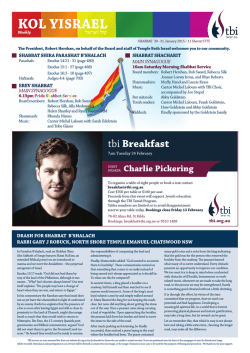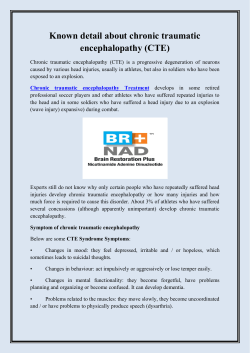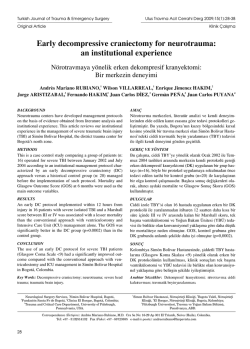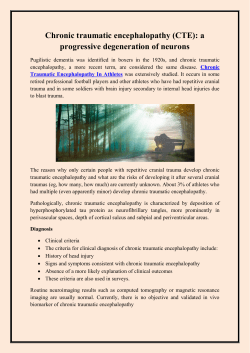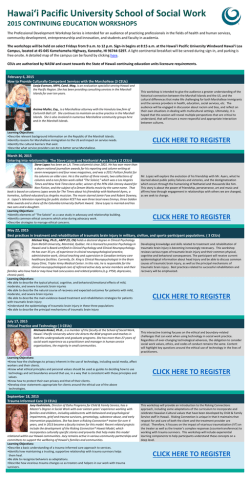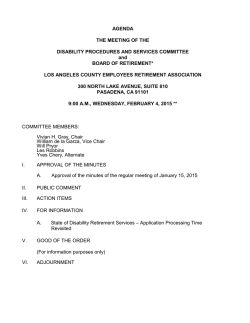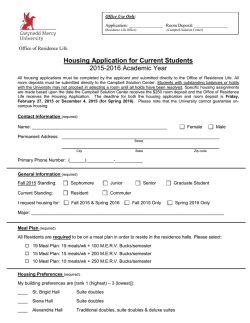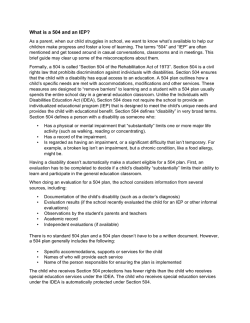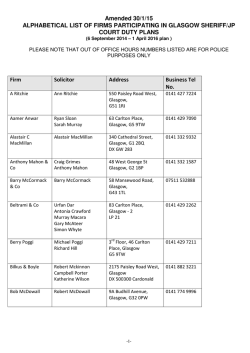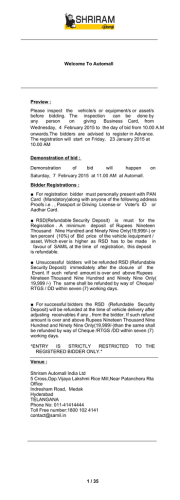
Download [ PDF ] - journal of evolution of medical and dental sciences
DOI: 10.14260/jemds/2015/202 ORIGINAL ARTICLE THE STUDY OF TRAUMATIC BRAIN INJURY AND ITS OUTCOME IN GOVERNMENT GENERAL HOSPITAL, GUNTUR K. P. Polaiah1, K. N. Madhavi2, Thokala Sivaiah3 HOW TO CITE THIS ARTICLE: K. P. Polaiah, K. N. Madhavi, Thokala Sivaiah. “The Study of Traumatic Brain Injury and its Outcome in Government General Hospital, Guntur”. Journal of Evolution of Medical and Dental Sciences 2015; Vol. 4, Issue 09, January 29; Page: 1435-1439, DOI: 10.14260/jemds/2015/202 ABSTRACT: BACKGROUND: The incidence of traumatic brain injury is increasing day by day and it is the major cause of morbidity & mortality in our country. So we have to study in detail about this kind of morbidity, mortality in the study group. OBJECTIVES: (1) To study traumatic brain injury in age and sex wise distribution. (2) To know the nature of the injury (3) To know the modified Glasgow coma scale score analysis in TBI. (4) To know the Traumatic Brain Injury patients out come by grading in Glasgow outcome scale. STUDY DESIGN: It is an observational study. STUDY AREA: Department of Anaesthesiology, Govt. General Hospital, Guntur. STUDY SUBJECT: Patients admitted in Govt. General Hospital for treatment. SAMPLE SIZE: 100 Traumatic Brain Injury Patients. STUDY PERIOD: July 2012 to April 2014. RESULTS: among 100 Traumatic Brain Injury patients, majority age was noted 36-45 years, male to female ration shows 7:3, Nature of Injury road traffic accidents were most common (61 patients), In our study 58 patients shows GCS 8-12, 42 patients shows <8, GCS < 8 had high mortality rate. Patient’s outcome studied by extended Glasgow outcome scale shows 42% mortality, 8% had severe disability, 22% had moderate disability, 28% had good recovery. CONCLUSION: High morbidly and mortality was observed among the TBI patients (study subjects) who sustained injury due to road traffic accident, having associated injuries and delayed admission into the hospital after injury. Males belong to 26-45 years of age was the maximum sufferers of TBI, when compared to females of same age group. KEYWORDS: Extra Dural Haematoma (EDH), Sub Dural Haematoma (SDH), Intra Cerebral Haemorrage (ICH), Sub Archonoid Haemorrage (SAH), Road Traffic Accident (RTI), Glasgow Coma Scale (GCS), ICU (Intensive Care Unit). INTRODUCTION: Head injuries are a social problem as they have high mortality and morbidity. Head injuries lead to loss of intellect and other faculties resulting in an increase burden to the family. Moreover majority of the people are young, middle age group, belong to the productive age group. The traumatic brain injury divided into mild, moderate, severe by 1) duration of unconsciousness 2) GCS Scale. in mild cases it is < 30 min duration of unconsciousness, GCS 13 – 15, in moderate more than 30 minutes duration of unconsciousness and less than 6 hrs, GCS 9 -12, in severe cases it is more than 6hrs of unconsciousness duration, GCS - 8 or less. Worldwide of all types of injury, those to the brain are among the most likely to result in death or permanent disability. Brain[1] injury is the leading cause of death and disability worldwide. United States Annually: One million Americans are treated and released from hospital emergency departments as a result of traumatic brain injury (TBI). 230,000 people[2] are hospitalized and survive 80,000 people[3] are estimated to be discharged from the hospital with some TBI-related disability[4] 50,000 people die[5] An estimated 5.3 million Americans are living today with disability related to traumatic brain injury. Most studies[6] indicate that males are far more likely to incur a TBI J of Evolution of Med and Dent Sci/ eISSN- 2278-4802, pISSN- 2278-4748/ Vol. 4/ Issue 09/Jan 29, 2015 Page 1435 DOI: 10.14260/jemds/2015/202 ORIGINAL ARTICLE as females. The highest rate of injury occurs in between the ages of 15-24 years. Persons under the age of 5 or over the age of 75 are also at higher risk. Europe Estimates suggest that sports related brain injury accounts for close to 300,000 injuries each year, with winter sports such as skiing and ice-skating accounting for close to 20,000 brain injuries.[7] MATERIAL AND METHODOLOGY: This is a prospective study, conducted in 100 patients admitted in GGH, Guntur a 1250 bedded multispecialty tertiary care Centre. We studied TBI according to age and sex wise distribution, nature of injury was evaluated. Patients were graded according to modified Glasgow Coma Scale and finally outcome was graded by Glasgow outcome scale. INCLUSION CRITERIA: Age 15- 65 yrs. ASA 1, 2, 3, 4 after trauma. EXCLUSION CRITERIA: Age group of less than 15 yr is excluded. Intracranial lesions before trauma. Heart diseases. Gunshot injuries. RESULTS: Age No of Patients Percentage 16-25 15 15 26-35 20 20 36-45 32 32 46-55 18 18 56-65 15 15 Table 1: Age Distribution for TBI Among 100 patients 15 were between 16-25 years, 20 were between 26-35 years, 32 were between 36-45 years. Majority of the age group were between 36-45 years. Nature of Injury No of Patients Percentage RTA 61 61% Assault 23 23% Fall from Height 16 16% Total 100 100% Table 2: Nature of Injury for TBI Out of 100 patients with TBI 61 patients had RTA and 23 patients had Assault and 16 patients had TBI due to fall from Height. J of Evolution of Med and Dent Sci/ eISSN- 2278-4802, pISSN- 2278-4748/ Vol. 4/ Issue 09/Jan 29, 2015 Page 1436 DOI: 10.14260/jemds/2015/202 ORIGINAL ARTICLE GCS No of Patients 13 – 15 8 – 12 <8 0 58 42 Out Come Percentage of Death (Death) 0 0 7 12.06 35 83.33 Table 3: GCS & Out Come for TBI In the present study among 100 patients 58 patients had 8 – 12 GCS score their outcome 7 (deaths), percentage of death was 12.06, 42 no. of patients had GCS score below 8, their outcome 35 (deaths) and percentage of death was 83.33. Outcome Scale No of Patients Percentage 1 42 42% 2-4 8 8% 5-6 22 22% 7-8 28 28 Table 4: Extended Glasgow outcome scale 1 = Dead, 2= Persistent vegetative state, 3= lower severe disability, 4= upper severe disability, 5 = Lower moderate disability, 6 = Upper moderate disability, 7= lower good recovery, 8= upper good recovery. In our study the outcome of TBI patients are assed by extended Glasgow outcome scale, shows 42% mortality was seen due to severe injury, 8% has severe disability (2-4), 22% had moderate disability (5-6), 28% had good recovery. DISCUSSION: The incidence of head injuries/traumatic brain injuries (TBI) is increasing day by day and this is the major cause of morbidity and mortality in developing countries. The rapid urbanization, industrialization, motorization and changing life styles of individuals had given rise to plethora of problems. In our study majority of age group in TBI patient belong to 36-45 years, correlating with Martins ET, Linhaves MN et al July 2009 mean age was 34.8 (+ 16.3) years and mortality was 33.3. Maximum deaths were seen in age group 51-60 years.[8] In this study the male ratio is high 7:3, (among 100 patients males are 76, female are 24) comparing with female, and it correlates with SS Dhandapani[9] D. Manju, B.SS. Sharma et al male, female ration is 7:1. Coming to the nature of injury we observed out of 100 patients with TBI, 61 patients had RTA, 23 patients had assault and 16 patients had TBI due to fall from height. These studies were correlating with Gururaj, G. Kolluri, S.V.R. et al [10] in their studies they found RTA 59%, falls (25%) and violence (10%) were the major causes of neurotrauma. According to modified GCS score, the TBI patients are divided into mild score is 13-15, moderate 12-8, severe <8, in the present study no patients are seen in mild group, among 100 J of Evolution of Med and Dent Sci/ eISSN- 2278-4802, pISSN- 2278-4748/ Vol. 4/ Issue 09/Jan 29, 2015 Page 1437 DOI: 10.14260/jemds/2015/202 ORIGINAL ARTICLE patients 58 patients had 8 -12 GCS score their outcome 7 (deaths), percentage of death was 12.06, 42 no. of patients had GCS score below 8, their outcome 35 (deaths) and percentage of death was 83.33. This study was correlating with Dhandapani SS D. Manju, BS Sharma et al in their study among the total 244 patients 25% had mild 67 had moderate, are 59% patients had severe TBI. Finally the outcome of traumatic brain injury patients were assessed by extended Glasgow outcome scale. Mortality (1) was seen in 42% of patients, severe disability was seen in 8% of case, moderate disability (5-6) was seen in 22% and good recovery (7-8) was seen in 28% of patients in our study. This study is correlating with Jourdan C [11] Bosserellev et al conducted cohort study, good recovery is seen in 19%, moderate disability in 43%, severe disability in 38%. CONCLUSIONS & RECOMMENDATIONS: RTA is the most common cause for TBI, males are more compare to females, majority of the age group was between 36-45 years, patients having low GCS score had poor prognosis. This can be prevented by reducing the traffic speed, by wearing helmets, seat belts and following the traffic rules. Improving the ambulance facilities to patients, early to hospital and early treatment will prevent extensive brain damage. Trauma care centres should maintain meticulous and comprehensive intensive care. In severe Traumatic Brain Injury with low GCS score patients will require skilled anaesthetists, critical care specialists, neurosurgeons, bed side nurses and respiratory therapists and other members of medial team. REFERENCES: 1. Centres for Disease Control and Prevention, Injuries and violence: the fact Geneva, World Health Organization 2010. 2. Data from the National Hospital Ambulatory Medical Care Survey, 1995-1996, of the National Centre for Health Statistics. 3. Data from the National Hospital Discharge Survey, 1996, of the National Center for Health Statistics. 4. Guerrero JL, Leadbetter S, Thurman DJ, Whiteneck G, and Sniezek JE. A method for estimating the prevalence of disability from traumatic brain injury. In preparation. 5. Unpublished data from Multiple Cause of Death Public Use Data from the National Center for Health Statistics, 1996. 6. Guerrero JL, Leadbetter S, Thurman DJ, Whiteneck G, and Sniezek JE. A method for estimating the prevalence of disability from traumatic brain injury. In preparation. 7. Thurman DJ, Branche CM, Sniezek JE. The Epidemioogy of Sports-Related Brain Injuries in the United States: Recent Developments. Journal of Head Trauma Rehabilitation 1998. 8. Martins ET, Linhares MN, Sousa DS et. al. Mortality in severe traumatic brain injury; a multivariated analysis of 748 Brazilian patients from Florianopolis city; journal of trauma. 2009 Jul; 67 (1): 85-90. 9. SS. Dhandapani, D. Manju, B.SS. Sharma et al Prognostic Significance of Age in TBI J. Neurosci. Rural Pract.2012. May-Aug 3 (2): 131-135. 10. Gururaj G. Kolluri SVR, Chandramouli B.A. Subba Krihsna. NIMHANS, First National Neuroscience conference, Bangalore September 10-12-2004. J of Evolution of Med and Dent Sci/ eISSN- 2278-4802, pISSN- 2278-4748/ Vol. 4/ Issue 09/Jan 29, 2015 Page 1438 DOI: 10.14260/jemds/2015/202 ORIGINAL ARTICLE 11. Predictive factors for 1 year outcome of a cohort of patients with severe traumatic brain injury (TBI); Results from the Paris - TBI study by Jourdan C, Bosserellev et al. Brain inj. 2013; 27 (9); 1000-7). AUTHORS: 1. K. P. Polaiah 2. K. N. Madhavi 3. Thokala Sivaiah PARTICULARS OF CONTRIBUTORS: 1. Assistant Professor, Department of Anaesthesiology, Guntur Medical College, Guntur. 2. Assistant Professor, Department of Obstetrics & Gynaecology, Guntur Medical College. 3. Assistant Professor, Department of Community Medicine, Guntur Medical College, Guntur. NAME ADDRESS EMAIL ID OF THE CORRESPONDING AUTHOR: Dr. K. P. Polaiah, Flat No. 204, Dream Homes Apartment, 1st Lane, Rajendra Nagar, Guntur-522006. E-mail: [email protected] Date of Submission: 16/01/2015. Date of Peer Review: 17/01/2015. Date of Acceptance: 22/01/2015. Date of Publishing: 27/01/2015. J of Evolution of Med and Dent Sci/ eISSN- 2278-4802, pISSN- 2278-4748/ Vol. 4/ Issue 09/Jan 29, 2015 Page 1439
© Copyright 2025
